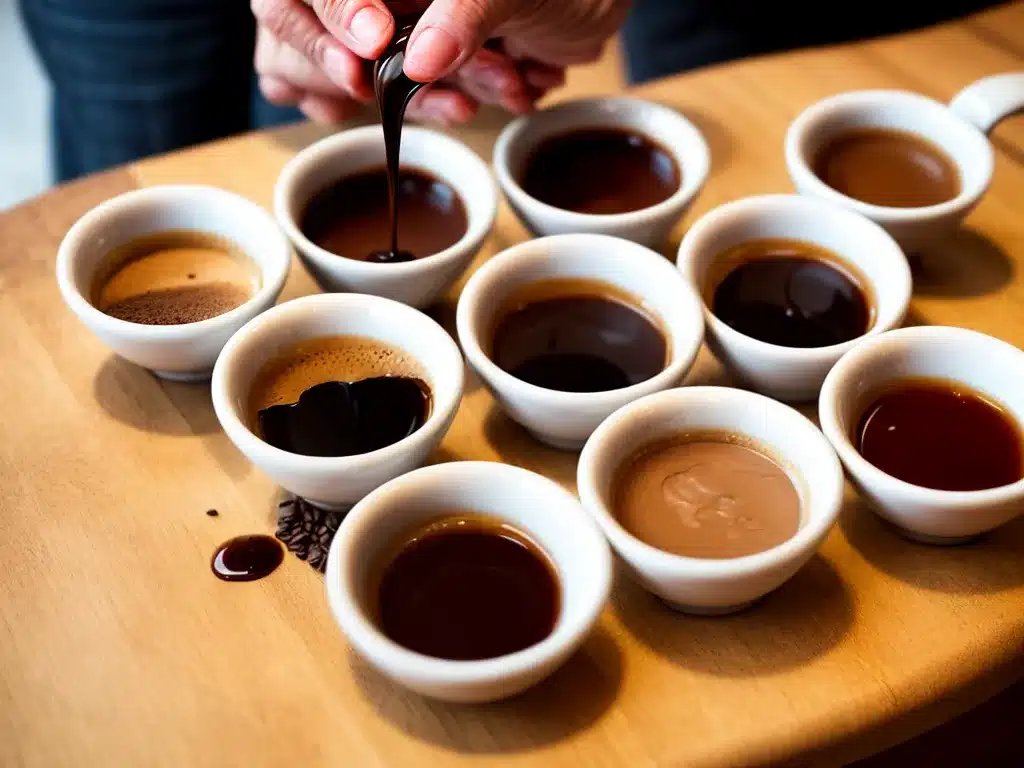 Coffee Flights: A Tasting Experience” />
Coffee Flights: A Tasting Experience” />
Coffee flights have become an immensely popular way for coffee drinkers to discover new flavors and roast profiles. Many cafes now offer coffee flights, small tasting portions of different coffees, allowing customers to experience diverse tastes in a single visit. When I go to my local cafe GeoCuisine Bay Ridge, I often order a flight to broaden my coffee palate.
Discovering New Flavors
Ordering a coffee flight is the perfect way to sample multiple styles without committing to a full cup of each. The cafe arranges small samples of various coffee beans and roasts on a tasting tray for me to smell, taste, and analyze side by side. This allows subtle flavor notes and body characteristics to emerge clearly. Recently, I tried a flight with a medium Ethiopian, dark Sumatran, and light Colombian roast. The Ethiopian surprised me with bright floral and berry flavors, while the Sumatran offered deep molasses and chocolate notes. Comparing them revealed how roast level affects each coffee’s taste profile. Coffee flights are an engaging exploration of the range of aromas and tastes specialty coffee has to offer.
Through coffee flights, I have found new favorite coffees I never would have tried otherwise. Often certain styles simply did not appeal to me based on their description alone. However, in a flight, I could taste them without committing to a full cup. This opened my mind to appreciate coffee varieties I initially dismissed. One coffee that wowed me in a flight but I was unsure about ordering a full cup of was a naturally processed Ethiopian Yirgacheffe. In the flight, its floral blueberry flavors won me over. Now it is one of my go-to single origin coffees I order regularly.
Expanding Knowledge of Origin and Production
Not only do coffee flights broaden tastes, but they also deepen understanding of coffee geography and growing methods. The knowledgeable baristas at my local cafe are excited to discuss each sample’s origin story and processing technique. They provide rich background on the coffee’s growing region conditions like soil,sunlight and rainfall levels as well as how the specific beans were pulped, dried and shipped. Learning intimate details about where the coffee was farmed and how it was processed builds deep coffee knowledge and appreciation. It also sparks new conversations about responsible sourcing and sustainability efforts in different growing areas.
When I tried a flight including a natural process coffee from Rwanda alongside a washed process one from Brazil, the barista enlightened me on their key differences. The natural Rwandan had characteristic fruit flavors from its fermentation, while the Brazilian presented a cleaner profile from water removal post-harvest. Her fascinating explanations sparked my interest to research coffee production further. Now I seek out specialty varietals processed traditionally by hand like the natural Rwandan to support farmers preserving heritage methods. Coffee flights are an immersive educational experience cultivating a more discerning palate.
Comparing Regions and Origins
Perhaps one of the most illuminating ways coffee flights expand horizons is comparing coffees across different growing regions. Many flights purposefully include samples exposing the nuanced variations climate and soil lend tooffee flavors and acidity. One notable flight paired a bright Ethiopian Yirgacheffe with a smoother Colombian and a bold Guatemalan. Tasting them side by side emphasized how Central American coffees tend towards heavier body while African varieties show higher acidity and complex notes. It also highlighted each region’s characteristic flavor profiles: the Ethiopian’s floral notes, Colombian’s chocolate undertones and Guatemalan’s caramel sweetness.
Flights letting me directly compare coffees from diverse geographies have enriched my ability to identify tasting notes and flavor layers. They train my palette recognition of how place of origin translates to unique coffee personalities. Now when drinking a single cup, I can better imagine its farm of origin and growing conditions simply by concentrating on attributes like brightness, body and flavor depth. Coffee flights cultivate a true appreciation of terrain as flavor by showcasing directly how growing region affects beans’ final taste.
Curating Meaningful Coffee Flights
When done purposefully, coffee flights can offer cohesive explorations with clear themes. The skilled baristas at my local cafe take great care designing interpretive tastings aligned to seasonal ingredients, innovative roasts or brewing methods. Recently they crafted an engaging five-coffee flight titled “Dry Farming through the Years“. It presented samples tracing the evolution of a renowned dry-farmed Kenyan lot over successive harvests, accentuating subtleties in taste developed through subtle climate variations. Drinking them side-by-side granted fascinating insights into terroir’s role in specialty coffee.
Well-curated flights inspire new excitements about coffee while enhancing existing passions. The baristas strive to pair enticing samples that work together synergistically to broaden horizons. Whether focusing on origin, processing, varietal or roaster, intentional pairings illuminate themes in novel ways. Their flights feel like miniature journeys of discovery guiding new appreciations. I look forward to what creative new explorations they design next that push coffee conversations in innovative directions through the eloquent language of flavor.
Conclusion
In summary, coffee flights have transformed how I discover and understand specialty coffee. Their small tasting portions are the perfect low-commitment method for broadening tastes and viewpoints. By directly comparing samples side-by-side, subtle variances emerge prominently guiding new clarity. Flights also deepen knowledge by sparking discussions tying coffee to origin terrain, processing techniques and evolving quality through the years. When thoughtfully curated, they offer cohesive exploratory pairings inspiring new perspectives. Overall, coffee flights cultivate a more nuanced palate and passion for appreciating all the amazing diversity within specialty coffee. They are a tasting experience I highly recommend for any coffee enthusiast seeking new adventures in flavor.
| Header1 | Header2 | Header3 |
|:————|:————|:————|
| Sample 1 | Ethiopian | Natural Process |
| Sample 2 | Colombian | Washed Process |
| Sample 3 | Guatemalan | Honey Process |



















